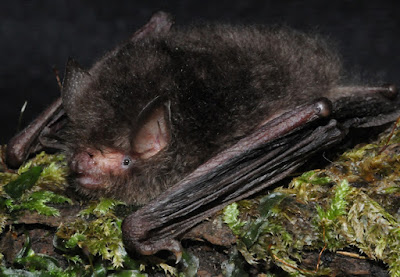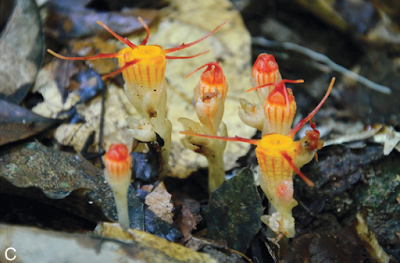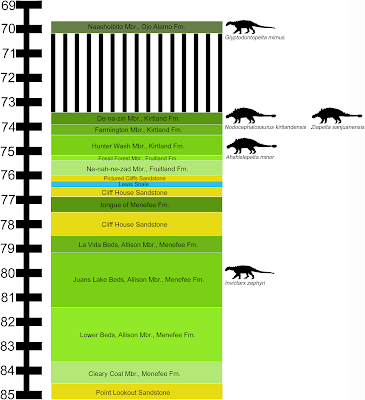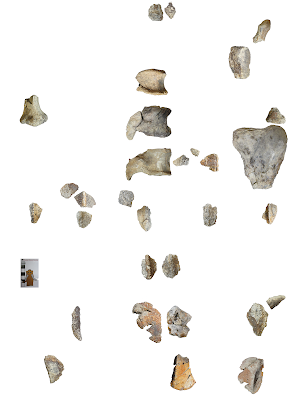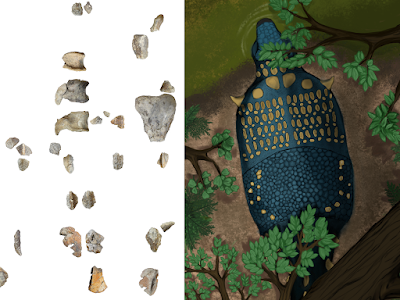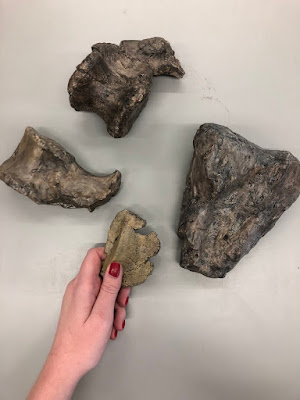[Most Recent Entries] [Calendar View]
Monday, August 27th, 2018
| Time | Event | ||||||
| 4:10a | [Herpetology • 2018] On Rhinella gildae (Anura: Bufonidae): Phylogenetic Relationship, Morphological Variation, Advertisement and Release Calls and Geographic Distribution
Abstract Anurans in the Rhinella margaritifera group have a long history of taxonomic confusion, mainly by morphological similarity between species and lack of acoustic and genetic data for many of the 19 described species. Herein, we presented data for Rhinella gildae based on recently collected specimens from its type locality. We provide patterns of morphological variation, measurements, advertisement and release calls and infer the phylogenetic position of R. gildae. The species geographical distribution was updated, occurring in two Amazonian localities in Maranhão state, and Cerrado areas in Maranhão and Tocantins states and also in a rainforest enclave inside Caatinga domain in Ceará state. Keywords: Amphibia, bioacoustics, morphology, Rhinella margaritifera Robson Waldemar Ávila, André Pansonato, Renata Perez, Vinicius Tadeu de Carvalho, Igor Joventino Roberto, Drausio Honorio Morais, Alexandre Pinheiro de Almeida., Rommel Rojas, Marcelo Gordo and Izeni Pires Farias. 2018. On Rhinella gildae Vaz-Silva, Maciel, Bastos & Pombal 2015 (Anura: Bufonidae): Phylogenetic Relationship, Morphological Variation, Advertisement and Release Calls and Geographic Distribution. Zootaxa. 4462(2); 274–290. DOI: 10.11646/zootaxa.4462.2.9 | ||||||
| 4:17a | [Mammalogy • 2018] A Revision of Kerivoula hardwickii and Occurrence of K. furva (Chiroptera: Vespertilionidae) in China
Abstract Although increased survey efforts using improved capture methods (particularly harp traps) have greatly expanded the quantity of Kerivoula specimens available in China, the understanding of the genus has been long constrained. After the recently published revision of the hardwickii-complex with the description of K. furva and re-evaluation of occurrence of K. titania in Taiwan, the critical overview of the previous data of Chinese Kerivoula (with the exception of K. picta, a strikingly colored and unmistakable species) is imperative. To clarify the taxonomy and distribution of the hardwickii-complex in China, 40 additional specimens collected from South China were studied through detailed morphological comparisons, multivariate statistical methods and phylogenetic inference. Our results evidently classified these specimens as K. furva instead of K. titania or K. hardwickii sensu stricto and together with the critical review of literature data indicate that all previous Chinese records of the two latter species were based on either misidentifications or outdated taxonomy. K. furva have so far been recorded in the Chinese provinces of Chongqing, Fujian, Guangdong, Guangxi, Hainan, Hunan, Jiangxi, Yunnan and Taiwan, but more field surveys are needed to confirm whether it could be found in other nearby provinces. Keywords: Mammalia, distribution, species determination, woolly bats
Wen-Hua Yu, Feng Li, Gábor Csorba, Zhong-Xian Xu, Xiao-Yun Wang, Wei-Jian Guo, Yu-Chun Li and Yi Wu. 2018. A Revision of Kerivoula hardwickii and Occurrence of K. furva (Chiroptera: Vespertilionidae) in China. Zootaxa. 4461(1); 45–56. DOI: 10.11646/zootaxa.4461.1.2 Hao-Chih Kuo, Pipat Soisook, Ying-Yi Ho, Gabor Csorba, Chun-Neng Wang and Stephen J. Rossiter. 2017. A Taxonomic Revision of the Kerivoula hardwickii complex (Chiroptera: Vespertilionidae) with the Description of A New Species. Acta Chiropterologica. 19(1); 19-39. DOI: 10.3161/15081109ACC2017.19.1.002 | ||||||
| 6:44a | [Herpetology • 2018] Lankanectes pera • A New Frog Species (Anura, Nyctibatrachidae) from Rapidly Dwindling Cloud Forest Streams of Sri Lanka
Abstract The monotypic genus Lankanectes, considered an evolutionary long branch with India’s Nyctibatrachus as its sister lineage, is represented by L. corrugatus, a species widely distributed within the wet zone of Sri Lanka up to 1500 m asl, where it inhabits a variety of lotic and lentic habitats. Here, following an integrative taxonomic approach using DNA-based phylogenies, morphology, morphometry, and ecological niche models, we describe a new species — Lankanectes pera sp. nov. The new species is distinguished from its sister species mainly by its tuberculated throat and absence of dark patches on venter, throat, manus and pes. The uncorrected genetic distances between the two Lankanectes species for a fragment of the non-coding mitochondrial 16S rRNA gene is 3.5–3.7%. The new species has a very restricted climatic distribution with a total predicted area of only 360 km2 (vs. 14,120 km2 for L. corrugatus). Unlike L. corrugatus, which prefers muddy substrates and marshy areas, the new species is observed inhabiting only pristine streams flowing through canopy covered montane forests in the highest reaches of the Knuckles Mountain range. The specialized new species will need immediate conservation attention due to its restricted distribution (montane isolate), specialized habit of inhabiting clear mountain streams, and small population size. Keywords: Amphibia, Ecological niche models, General lineage concept, Knuckles Mountains, Montane-isolate
Lankanectes pera, sp. nov. Etymology. The specific epithet pera is applied as a noun in apposition. It is a reference to the University of Peradeniya, Sri Lanka, affectionately referred to as “Pera” by its alumni. Distribution: Lankanectes pera sp. nov. is restricted to streams flowing through the montane forests on highest peaks of the Knuckles Mountain range—1100 m asl, in Dothalugala and Bamabarella and Riverston regions. Gayani Senevirathne, V.A.M.P.K. Samarawickrama, Nayana Wijayathilaka, Kelum Manamendra-Arachchi, G. Bowatte, D.R.N.S. Samarawickrama and Madhava Meegaskumbura. 2018. A New Frog Species from Rapidly Dwindling Cloud Forest Streams of Sri Lanka—Lankanectes pera (Anura, Nyctibatrachidae). Zootaxa. 4461(4); 519–538. DOI: 10.11646/zootaxa.4461.4.4 | ||||||
| 7:09a | [Botany • 2018] Lectotypification of Thismia arachnites (Thismiaceae), A Mysterious Species Newly Reported for Thailand
Summary Thismia arachnites Ridl., previously known only from Perak, Malaysia, is newly reported in tropical lowland forest in south-eastern and peninsular Thailand. A detailed description and photographs are provided. In addition, a lectotype is also designated here. Key Words: Distribution, mycoheterotrophic, Thai-Malay Peninsula, typification Thismia arachnites Ridl. (Ridley 1905: 197). Type: illustration of Thismia arachnites, Malaysia, Perak Hills, tea gardens, Feb. 1904, drawn by H. N. Ridley (lectotype K!, selected here, Fig. 1). DISTRIBUTION: Malaysia and Thailand. HABITAT AND ECOLOGY: In Thailand, Thismia arachnites was found growing on humus, in lowland evergreen forests; alt. 50 – 250 m.
Sahut Chantanaorrapint. 2018. Lectotypification of Thismia arachnites (Thismiaceae), A Mysterious Species Newly Reported for Thailand. Kew Bulletin. DOI: 10.1007/s12225-018-9765-2 | ||||||
| 7:37a | [Paleontology • 2018] Invictarx zephyri • A New Nodosaurid Ankylosaur (Dinosauria: Thyreophora) from the Upper Cretaceous Menefee Formation of New Mexico
Abstract Nodosauridae is a clade of armored dinosaurs with a rich fossil record and long history of study in North America. Nodosaurid fossils have been collected throughout the western United States and Canada. Here, we report three new nodosaurid specimens from the Upper Cretaceous (lower Campanian) Allison Member of the Menefee Formation, San Juan Basin, northwestern New Mexico. The three specimens belong to a new genus and species, Invictarx zephyri, characterized by a unique combination of features pertaining to the morphology of the osteoderms. Among the three specimens there are representative cervical/pectoral and thoracic osteoderms, as well as components of a probable co-ossified pelvic shield. The new tax on is most similar to Glyptodontopelta mimus from the Maastrichtian of New Mexico.
Systematic paleontology Dinosauria Owen, 1842, sensu Baron, Norman & Barrett, 2017 Ornithischia Seeley, 1888, sensu Sereno, 2005 Thyreophora Nopcsa, 1915, sensu Sereno, 2005 Ankylosauria Osborn, 1923, sensu Sereno, 2005 Nodosauridae Marsh, 1890, sensu Sereno, 2005 Invictarx zephyri gen. et sp. nov. Holotype: WSC 16505, incomplete postcranial skeleton including fragments of a dorsal rib, six complete or partial identifiable osteoderms (WSC 16505.1–WSC 16505.6), and fragments of additional osteoderms. Referred specimens: Natural History Museum of Utah (UMNH) VP 28350, incomplete postcranial skeleton including three dorsal vertebrae, fragments of dorsal ribs, distal end of left humerus, distal end of left ulna, proximal ends of left and right radii, incomplete metacarpal, numerous incomplete but identifiable osteoderms, and fragments of additional osteoderms; UMNH VP 28351, incomplete postcranial skeleton including fragments of several dorsal centra, fragments of dorsal ribs, numerous incomplete but identifiable osteoderms, and fragments of additional osteoderms. Etymology: Invictarx is derived from the Latin words invictus (“invincible, unconquerable”) and arx (“fortress”), in reference to the well-armored nature of ankylosaurian dinosaurs. The specific name, zephyri, is the genitive form of the Latin masculine noun zephyrus, “west wind,” in reference to the blustery conditions that prevail among the outcrops where the specimens were discovered. The full name may be translated as “unconquerable fortress of the western wind.” Locality: All specimens were collected in San Juan County, New Mexico, on land administered by the U.S. BLM. Precise locality data are on file at WSC, UMNH, and the BLM. Horizon: All specimens were collected from outcrops of the Juans Lake Beds (Miller, Carey & Thompson-Rizer, 1991) (Fig. 1), upper part of the Allison Member, Menefee Formation; lower Campanian, Upper Cretaceous (Molenaar et al., 2002; Lucas et al., 2005). Specific diagnosis (as for genus by monotypy): nodosaurid ankylosaur distinguished by the following unique combination of characters: (1) observable on WSC 16505, UMNH VP 28350, and UMNH VP 28351 cervical/pectoral, thoracic, and pelvic osteoderms exhibit overall smooth surface texture, with little or no projecting rugosity, with abundant pits distributed randomly over the entire external surface, and with no neurovascular grooves or a small number of bifurcating and non-bifurcating neurovascular grooves distributed randomly, similar to Glyptodontopelta mimus but lacking the dense pattern of dendritic grooves that characterizes that taxon (Burns, 2008; Burns & Currie, 2014); (2) observable on WSC 16505 and UMNH VP 28351 some thoracic osteoderms exhibit a low, rounded keel with a deep groove extending craniocaudally along the apex, also present in the ankylosaurids Anodontosaurus lambei (Fig. 13G in Penkalski (2018)) and Platypelta coombsi (Fig. 13O in Penkalski (2018)) (P. Penkalski, 2018, personal communication), but absent in G. mimus (Burns, 2008); and (3) observable on UMNH VP 28351 probably possessed a co-ossified pelvic shield consisting of polygonal osteoderms of uniform size (Category 3 of Arbour, Burns & Currie (2011)), similar to some other nodosaurids, including Nodosaurus textilis (Lull, 1921), Stegopelta landerensis (Moodie, 1910), G. mimus (Ford, 2000; Burns, 2008), and Europelta carbonensis (Kirkland et al., 2013), as well as the ankylosaurid Aletopelta coombsi (Ford & Kirkland, 2001; Arbour & Currie, 2016). .... Conclusions: The new nodosaurid I. zephyri provides further insight into the poorly known vertebrate fossil record of the Allison Member of the Menefee Formation. Although the known material is fragmentary, the osteoderms exhibit a unique combination of characters. The occurrence of Invictarx in the early Campanian of southern Laramidia aligns with previous hypotheses that nodosaurids were present in Laramidia throughout the Late Cretaceous, even as ankylosaurids suffered a local extinction and later reinvaded from Asia (Arbour, Zanno & Gates, 2016). Andrew T. McDonald and Douglas G. Wolfe. 2018. A New Nodosaurid Ankylosaur (Dinosauria: Thyreophora) from the Upper Cretaceous Menefee Formation of New Mexico. PeerJ. 6:e5435. DOI: 10.7717/peerj.5435 |
| << Previous Day |
2018/08/27 [Calendar] |
Next Day >> |



